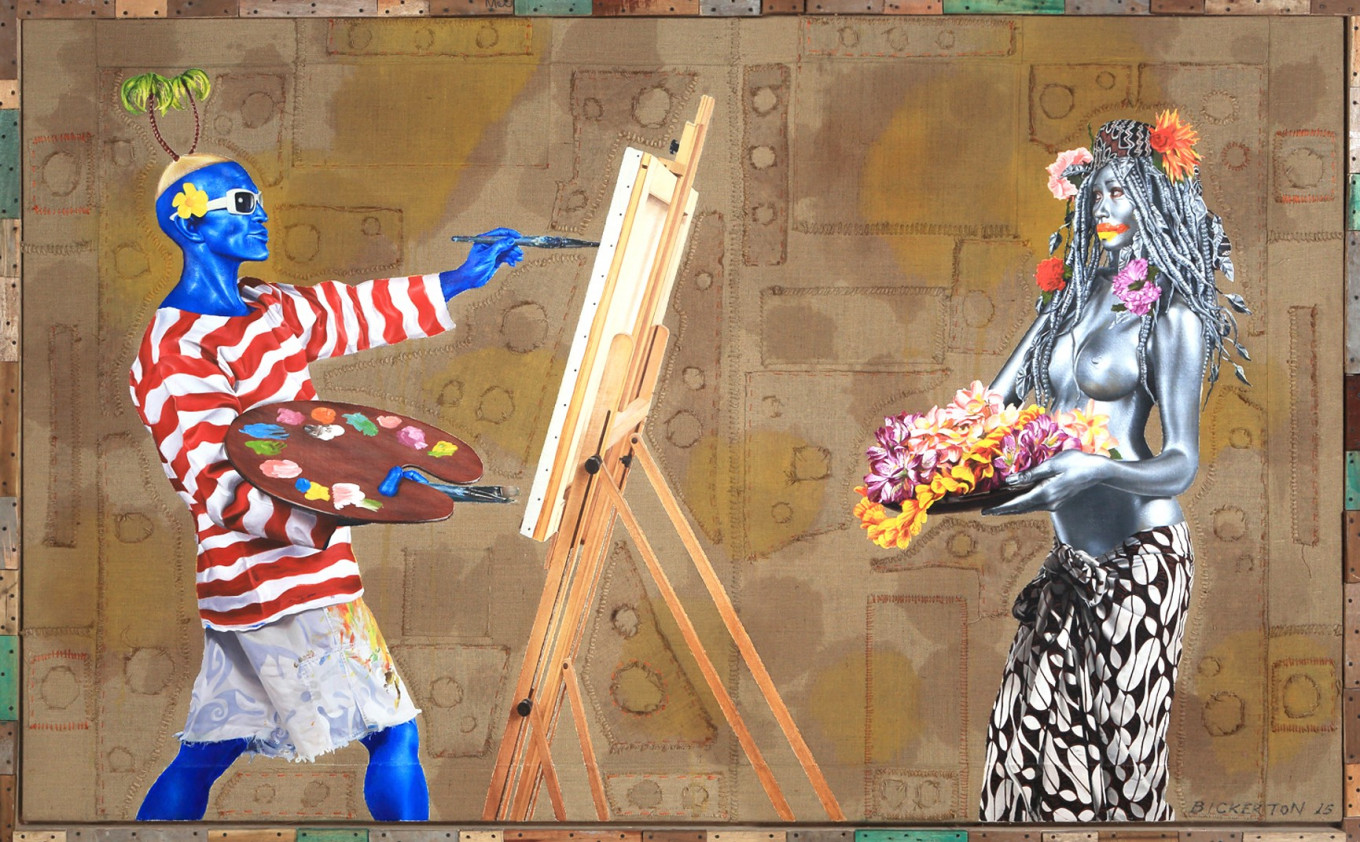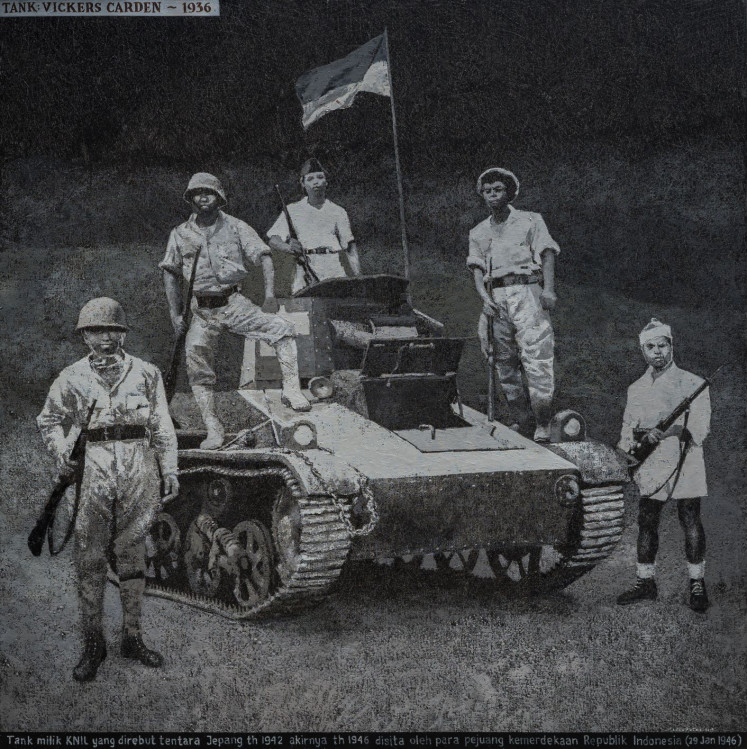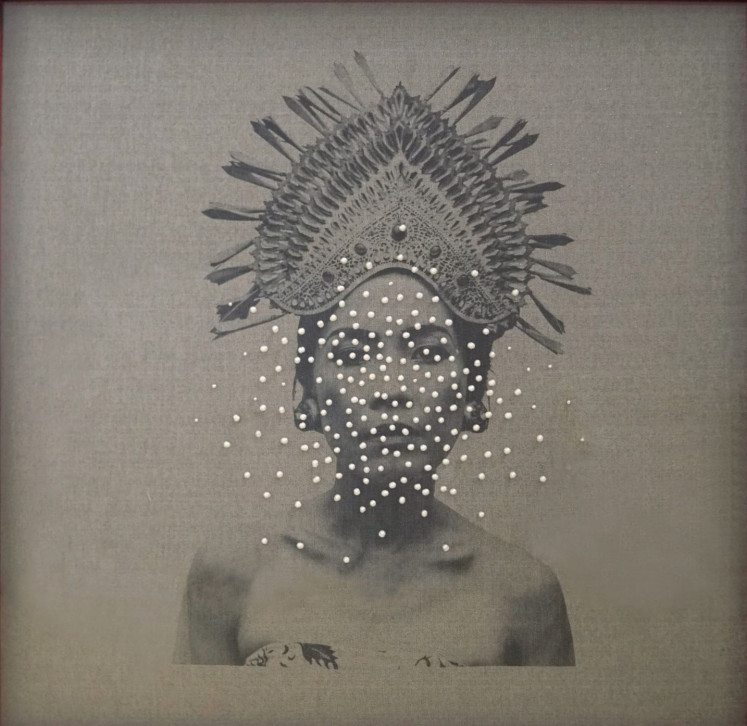Popular Reads
Top Results
Can't find what you're looking for?
View all search resultsPopular Reads
Top Results
Can't find what you're looking for?
View all search results‘(Re)Imagining The Image’: Southeast Asian artists explore identity in reflection
Change text size
Gift Premium Articles
to Anyone
 Farcical portrayal: Ashley Bickerton, 'Sanur beach after Le Mayeur & Ni Pollok' (mixed media on jute, 2014). Bickerton is among the renowned expatriate artists who live on Bali whose work has entered the collections of the Museum of Modern Art and the Guggenheim Museum in New York, as well as the Tate Gallery in London. (Courtesy of Gajah Gallery/-)
Farcical portrayal: Ashley Bickerton, 'Sanur beach after Le Mayeur & Ni Pollok' (mixed media on jute, 2014). Bickerton is among the renowned expatriate artists who live on Bali whose work has entered the collections of the Museum of Modern Art and the Guggenheim Museum in New York, as well as the Tate Gallery in London. (Courtesy of Gajah Gallery/-)
A
group exhibition has invited eight prominent contemporary artists from Southeast Asia, including five artists from Indonesia, to confront and engage with images that span the region’s colonial era to the present.
In the “(Re)Imagining The Image” exhibition, held until Oct. 4 at Gajah Gallery in Singapore, the artists draw upon a plethora of photographs from present-day personal pictures they took themselves to archival photographs that shed light on lost histories in their country of origin.
They then reproduced, contrasted, concealed, distorted or subverted these original images into vivid, individual objects of art in their own right, from screen prints on fabric to watery ink on paper, to hyperrealistic oil paintings on canvas and three-dimensional, mixed media.
Mangu Putra, 'Vickers Carden' (oil and acrylic on canvas, 2014) (Courtesy of Gajah Gallery/-)
The show’s curator Nicole Soriano said that the exhibition aimed to encourage curiosity and critical understanding of images that shaped cultures and histories.
“It is crucial that both artists and audiences understand that they are part of these histories, not detached from them,” Soriano told The Jakarta Post in an email interview on Tuesday.
For instance, she said that the original captions that accompanied colonial-era images were not fixed, and that they did not have the final say.
“The artists, in manipulating these photographs and injecting their artistic hand, also partake in the ‘captioning’ of these images and in the shaping of collective narratives,” she said.
The five artists from Indonesia invited to exhibit their works are Ashley Bickerton, Fika Ria Santika, Jumaldi Alfi, Mangu Putra and Octora, along with their contemporaries Ahmad Zakii Anwar of Malaysia, Suzann Victor (Singapore/Australia) and Li Jin of China.
The artists each had a distinct interest in photographic images, whether colonial or contemporary. This reflected their strong awareness of how images affected their own understanding of their histories, identities and relationships to the present world, and how they constantly questioned the power of imagery through their art, noted Soriano.
“Yet, though the artists are connected by this shared inclination, we also made it a point to bring together artists of different backgrounds and practices,” she added.
While some artists reexamined colonial photographs from their hometowns or countries, others used photographs taken in places where they are foreigners, as in the case of Ashley Bickerton, who is among the best-known expatriate artists residing in Bali; and Chinese artist Li Jin, whose works draw from his daily life and his travels. Both of them are very self-reflexive about their roles as an expatriate or visitor in Bali.
Others staged and directed shoots specifically to produce the photographs they used in their exhibition pieces, while others stuck to archival images taken by other photographers.
Girl with pearls: Recasting herself as a portrait model in 'Give Me Pearls Necklace' (screen print on fabric, freshwater pearls, 2018), Indonesian artist Octora appears to gaze out from and on history, questioning how portraiture can be a tool of power and domination over colonial subjects. (Courtesy of Gajah Gallery/-)Octora recreated an ethnographic portrait of a Balinese woman by casting herself in the role of the photographic subject. She then incorporated detailed accents like freshwater pearls to obscure her face in the finished work.
“In altering and obscuring the original photographs, she radically intervened [in] the long-held narratives surrounding these images, and reclaimed control over the way images are used to define the past,” Soriano said.
Meanwhile, Jumaldi Alfi, a founding member of one of Indonesia’s prominent art collectives, the Jendela Art Group, was drawn to an enigmatic black-and-white photograph of Mount Bromo dating back to the Dutch colonial era.
In his work, Jumaldi replicated the image in his work to reread the landscape and dig deeper into the stories and realities it concealed. In doing so, he questioned how such landscapes were used in a similar manner during the Mooi Indie phase of Indonesian art history to portray the country as romantic and picturesque.
“In juxtaposing these diverse perspectives, we hoped to illuminate unexplored connections and nuances across the artists’ contexts both within Indonesia and across Southeast Asia,” Soriano said.
“We want audiences to feel they can also engage in a similar experience, that they can and should also ask questions like, ‘Why does this picture intrigue me? Who was the person behind or before the camera? Do I agree with how this subject or scene was portrayed? How does this image relate to my present-day realities?’
“While these questions may never truly be answered, we hope to share the fulfillment in wrestling with them.”
-- “(Re)Imagining The Image” is a free exhibition, with the gallery implementing health and safety measures including temperature checks, contact tracing and limited visitor admittance in line with the Singapore government’s policies.












